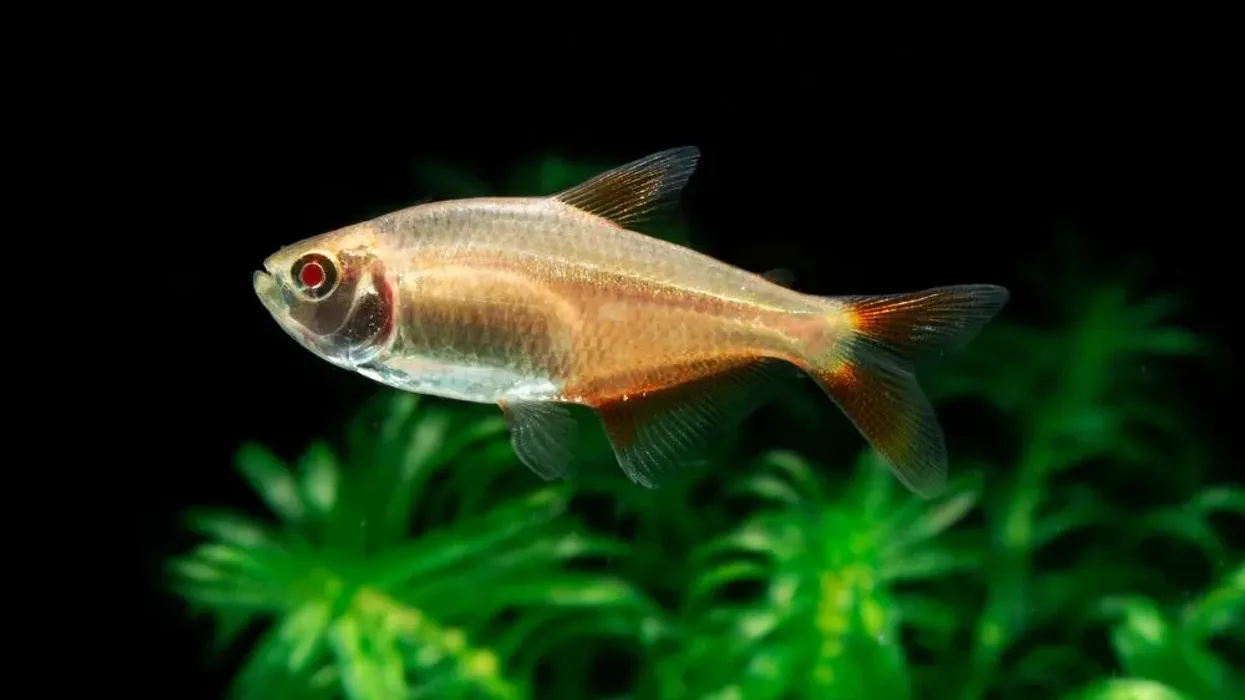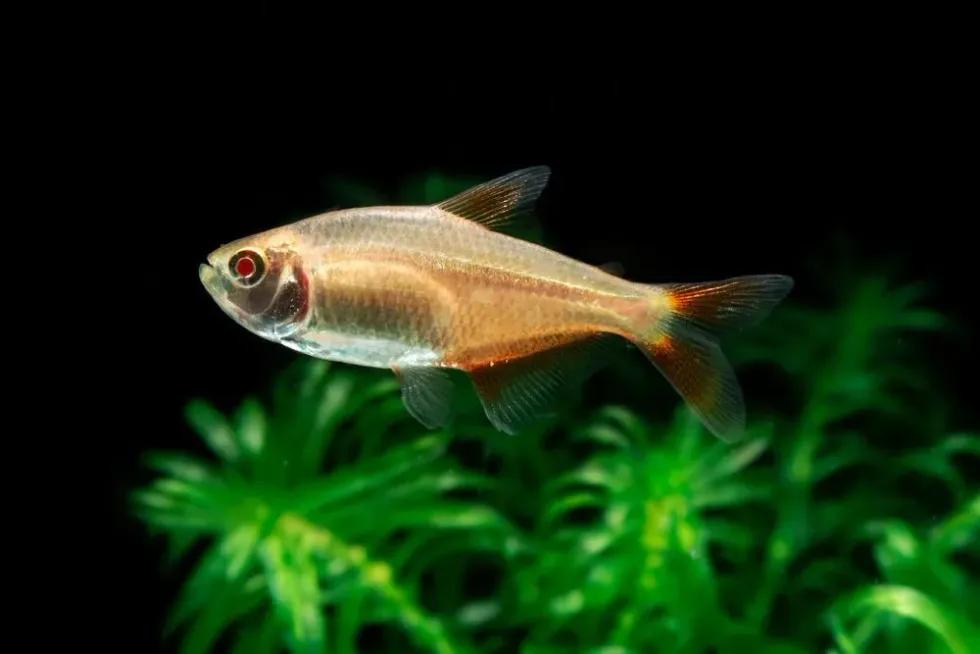On your visit to a pet fish market, it is quite easy to come across the silver and metallic Buenos Aires tetra fish. It is a common community tank fish species; however, it originally belongs to the freshwater habitats of South America.
It has the scientific name Hyphessobrycon anisitsi. The fish doesn't grow too large, and even the Buenos Aires tetra care is relatively easy.
Hence, fish has become a good choice for beginning aquarium enthusiasts. The fish has a habit of nibbling and feeling on live plants in its native environment, and it repeats the same thing when it's kept in a tank.
Their lifespan is around three to five years, but some might live longer. Albino or yellow variants are also found on the pet market, but it is mostly a result of artificial breeding.
Another great thing about this species is that it doesn't fuss over food, so feeding is easy. A Buenos Aires tetra school looks spectacular when its silvery bodies shine under bright lights.
Find the Buenos Aires tetra interesting? Keeping reading to learn spectacular Buenos Aires tetra facts. Also, check out the neon tetra and the electric eel to know more about fish.
Buenos Aires Tetra Interesting Facts
What type of animal is a Buenos Aires tetra?
The Buenos Aires tetra (Hyphessobrycon anisitsi) is a fish that is commonly seen in aquariums.
What class of animal does a Buenos Aires tetra belong to?
The Buenos Aires tetra belongs to the class Actinopterygii and the family Characidae.
How many Buenos Aires tetras are there in the world?
The exact number of Buenos Aires tetras isn't known because the fish is extensively bred to be kept in aquariums.
Where does a Buenos Aires tetra live?
The Buenos Aires tetra fish belongs from South America, where it is mainly found in Argentina's La Plata region. It is also found in Paraguay as well as in southeastern Brazil. Currently, the tetras are also found all over the world as they are sold as pets.
What is a Buenos Aires tetra's habitat?
The Buenos Aires tetra (Hyphessobrycon anisitsi) is a freshwater fish, and in its natural habitat, the tetra lives in rivers, ponds, lakes, and streams. The fish has a preference for slow-moving water bodies.
Who do Buenos Aires tetras live with?
Buenos Aires tetras may live in a relatively small school when it is in their natural habitat. It would help if you were careful about keeping the fish in a community tank, as Buenos Aires tetra fin nipping is quite common.
Hence, their tank mates should be chosen carefully. As it is a schooling fish, the tetras like to stay in groups of at least six fish.
How long does a Buenos Aires tetra live?
The average lifespan of a Buenos Aires tetra is around three to five years, but some have managed to live a longer life with proper care.
How do they reproduce?
Reproduction is an important part of the lives of a Buenos Aires tetra fish. The female fish can produce up to 2000 eggs while spawning. The species try to lay eggs in areas with plants so that the eggs can attach to the leaves.
The eggs are transparent and look like water droplets. After the female tetras lay the eggs, the males will also release their sperm to fertilize the eggs. The parents do not have any role to play in bringing up the newborn Buenos Aires tetra fry.
The fish may breed several times a year. The fish spawns when the water is slightly warm.
The spawned eggs get attached to live plants present around the spawning spot. Eggs hatch in 24-48 hours, and the fry is immediately on its own. It feeds on infusoria for the first few days and grows up quite quickly.
What is their conservation status?
The Buenos Aires tetra is yet to make it onto any conservation lists so it can be said they are not in danger of extinction anytime soon.
Buenos Aires Tetra Fun Facts
What do Buenos Aires tetras look like?
(Buenos Aires tetra facts are great for kids.)
The Buenos Aires tetra has a simple look. It is a silver metallic fish with a red-colored tail fin and anal fin. Its dorsal feel may also have a tinge of red color.
The fish also has a black cross or a black diamond-shaped marking in the area where the fins meet its body. It is a medium-sized fish with a flattened body. As the shiny metallic scales reflect light, the fish may almost look neon under bright conditions.
An albino Buenos Aires tetra variant is available in the pet market, and it has most likely been artificially made by humans. The albino tetra has an almost transparent look when kept under bright light.
A yellow variant is also available in the market. The color of a tetra often depends on its diet and proper water conditions, so the aquarium should always be maintained. The tetra fish males tend to be more colorful, while the females have longer bodies with rounded tummy areas.
How cute are they?
As a plain-looking fish, the Buenos Aires tetra fish can seldom be described as cute. However, its metallic body, along with the neon sheen, does make the fish look majestic and extremely beautiful.
How do they communicate?
Though a lot isn't known about the communication process of the fish, the Buenos Aires tetra fish tends to have a bullying problem. It can nip the fins of a long-finned fish or push the smaller fish around the aquarium.
How big is a Buenos Aires tetra?
The Buenos Aires tetra size is around 3 in (7.5 cm). The Buenos Aires tetra fully grown is slightly bigger than the cardinal tetra which usually grows to a size of 2 in (5 cm).
How fast can a Buenos Aires tetra swim?
The Buenos Aires tetra isn't a very fast swimmer. As a social fish, the tetras often swim in schools, and it dwells in slow-flowing water.
How much does a Buenos Aires tetra weigh?
Not much is known about the exact weight of the Buenos Aires tetra, but we can guess that it will be quite lightweight.
What are the male and female names of the species?
There are no separate names for the male and female Buenos Aires tetra fish.
What would you call a baby Buenos Aires tetra?
The baby Buenos Aires tetra is called a fry.
What do they eat?
The Buenos Aires tetra loves to nibble on live plants, and its diet is often vegetation-based. People may often find that the live plants in an aquarium have been completely eaten by this tetra species.
This fish even can chomp down on plants that are usually left alone by other fish species. However, as an omnivorous fish species, the tetra also eats worms, crustaceans, and various aquatic insects. If you have kept the fish in an aquarium, then remember to feed it high-quality flake food.
Tetras should also have availability to live food like bloodworms and brine prawns as it helps to maintain the color present in its anal fins. Tetras aren't fussy about food, and they can eat almost every food that is available in the market.
You can also let them eat frozen fish food. Include enough vegetables and plants in its diet as they seem to love comping on plants.
Give food to the fish around two or three times a day to satiate its hunger. Some people also like feeding the fish with blanched vegetables like spinach and lettuce.
Are they aggressive?
Yes. Even after being a beginner-friendly community fish, one of the drawbacks is the Buenos Aires tetra's aggressive temperament, which includes biting the fins of a long-finned fish.
You should be very careful about choosing suitable Buenos Aires tetra tank mates for the tetras. It has a habit of bullying fish that are smaller than it. Moreover, it is best to keep the tetra fish in a group of six of its species.
Would they make a good pet?
Yes, the Buenos Aires tetra is a great pet, and it is extremely easy to take care of these fishes. Except for the choice of proper tank mates, not much fuss is needed to keep these fish.
The Buenos Aires tetra tank size for a single fish should be around 30 gallons.
However, it is better to keep the fish in a school of six or more fish of the same species, so increase the tank size accordingly. It would be best if you refrained from keeping the fish in the tiny 10-gallon tank that is usually recommended by some pet shops.
The Buenos Aires tetra is easily available in the pet market and with fish breeders. The Buenos Aires tetra prices vary, and it's usually $2.99 for a single fish.
The albino or yellow variants may cost you more. To give your fish the best care, make sure to install proper water filters that help to keep the water fresh and oxygenated. As it has been already told, this fish is devoted to living plants, and Java ferns work best in a tetra tank.
If you are breeding the tetra in an aquarium, it is important to keep an eye on the fish. As the species live in warm water, it needs to have the same water conditions in an aquarium to initiate spawning.
The water for a Buenos Aires tetra also needs to be slightly acidic. The fish can spawn in groups or a pair.
The ideal temperature of the fish is somewhere between 64-82°F (18-28°C ). So, the water's temperature shouldn't be too cold or too warm. Once the eggs have settled on the plants, you should be quick with removing the Buenos Aires tetra eggs from another aquarium.
This is important as the tetra can eat the eggs after spawning. If breeding is successful, the eggs will hatch in 24-48 hours, and you will have free-swimming fish all over the aquarium.
The diet of a fry includes infusoria, which derives from plants. Start feeding the young fish with live food or commercial fish food once it has grown larger.
Did you know...
Compatible tank mates for Buenos Aires tetras include the Congo tetra, Apistogramma, Bolivian ram cichlid, black skirt tetra, and dwarf gourami.
You can tell a Buenos Aires female is pregnant by looking at its swollen belly. Choose the most colorful males to make the breeding success.
Where does the Buenos Aires tetra get its name?
Buenos Aires tetra is commonly found in Argentina's La Plata region of the country's capital city, Buenos Aires. Hence, the fish has been named after the city.
Can Buenos Aires tetras survive in brackish waters?
As a freshwater fish species, the Buenos Aires tetra fish cannot survive in brackish or salty water. When the fish is kept in an aquarium, it is important to maintain a water hardness level of up to 35 dGH and a pH level of 5.8-8.5.
You should regularly clean the tank and change the water to provide the fish with good water conditions. Please do not give the fish any more food than it eats as the uneaten food can turn the water cloudy.
Here at Kidadl, we have carefully created lots of interesting family-friendly animal facts for everyone to discover! Learn more about some other fish including the Congo tetra and the black neon tetra.
You can even occupy yourself at home by drawing one of our Buenos Aires Tetra coloring pages.








